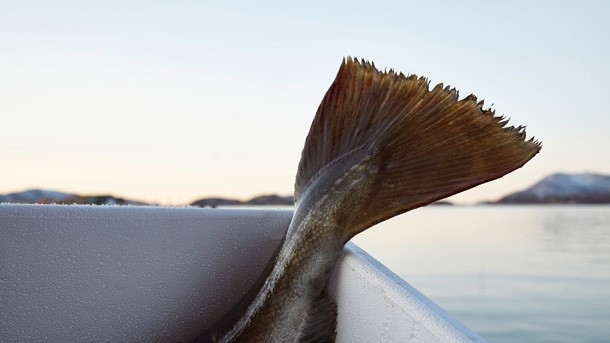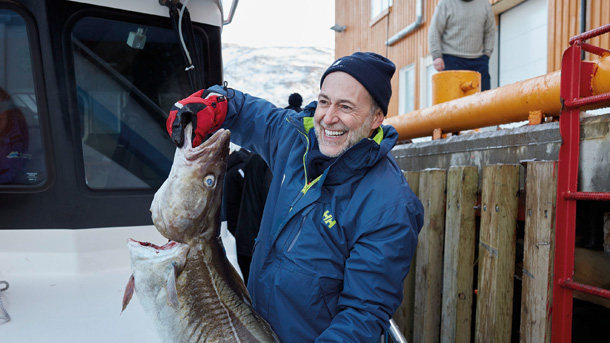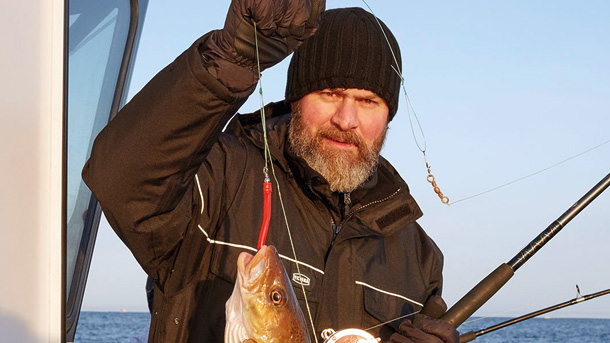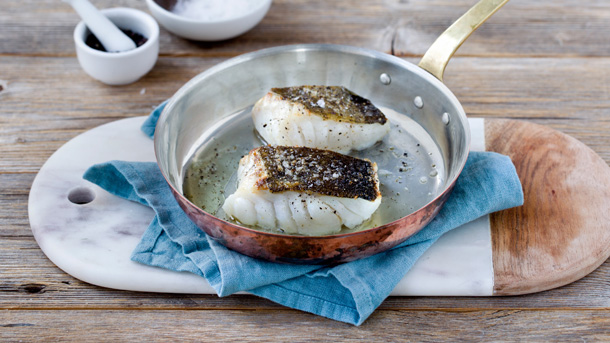FEATURE
In search of Skrei: fishing for the king of cod in Norway

Although its appearance is only brief, it is welcomed by the sun-starved inhabitants of this small coastal community, which has spent the past few months in near total darkness.
Not only does the sun’s return mean brighter days are ahead, it also heralds the start of the season for Skrei (pronounced skray), the prized cod that populates Norway’s cool and clear waters between January and April.
It is this that the chefs on board the fishing boat Skaaskjaer are hoping will end up on the end of their lines.
The fishing expedition is being led by Michel Roux Jr, an ambassador for Skrei in the UK, who is accompanied by chefs including Nieves Barragán Mohacho from Barrafina, The Frog’s Adam Handling, Glynn Purnell, Simon Hulstone from The Elephant in Torquay, Luke Tipping from Simpsons in Birmingham and The Ritz’s Ruth Hansom.
A photographer is also on board to capture the moment the big catch is reeled in and there’s also a group of journalists, of which I am one, brought in to document the proceedings. It is ice cold, and the not-so-modest amount of Norwegian beer that was consumed the previous night is having an effect on a number of the crew, to the mild enjoyment of the Skaaskjaer’s skipper. And all in the name of catching cod.
Skrei fan: Michel Roux JR
A 1,000km journey
This is not just any cod though. The prize the chefs are fishing for has long been one of Norway’s best-kept secrets, although in more recent times Skrei has started to appear on restaurant menus of chefs who are aware of its superior quality. While cod is often regarded as one the most mundane of fishes in the UK, typically battered and deep fried and served with a side of chips and mushy peas, Norwegian Skrei is an altogether different culinary proposition.
Skrei cod are in the prime of their life – the fish are around only five years old when they are caught – owing to the long migratory journey that they take. The fish spend most of their life in the nutrient-rich Barents Sea before undertaking the 1,000km journey back to their birthplace to spawn (the name Skrei comes from the Norse word ‘skrida’, which means to wander), which is when they are caught. By this time they have developed the muscles that give Skrei their characteristic firm texture and beautiful taste.
Hundreds of millions of Norwegian cod migrate each year back to their spawning grounds, yet only a small percentage (10% to 13%) of all landed cod will carry the Skrei seal of approval. Norway typically produces 8,000 to 10,000 tonnes of Skrei per season depending on availability, a third of which is consumed domestically.
Spain, Germany and Sweden are the biggest markets for it outside of Norway. The UK is mainly a restaurant market for Skrei and imports around only 100 tonnes of Skrei each season, a figure that has increased threefold in the past few years.
“It has been highly encouraging to see the demand for Skrei increasing since its introduction to the UK in 2012 – sales have tripled in this period.” says Jack Robert Møller, UK director at the Norwegian Seafood Council.”We have strong support from the premium retailers, not to mention the finest chefs and fishmongers. This support has allowed Skrei to be a fantastic sales success across the UK and Europe.”
Møller expects this year’s exports of Skrei to Europe to be between 3,000 and 5,000 tonnes, depending on availability of the fish.
To be labelled as Skrei, not only must the cod have been caught during its spawning season, but it has to meet numerous standards that ensure it reaches the user in the best possible condition. This starts the moment it is caught and continues through its killing, gutting, handling, packaging and storing. Inspectors known as ‘skrei policeman’ – or ‘Skreipatruljen’ – make regular checks to ensure standards are met throughout the process.
Those that don’t adhere to these standards face temporary or even permanent closure, such is the serious nature of the business.
Once Skrei has been caught it must be removed from nets quickly so that it doesn’t drown or get damaged. It must then be bled alive in running seawater for around 30 minutes and subsequently kept in pre-cooled clean seawater.
The process of bleeding the fish alive ensures that all the blood is drained from the fish, which gives Skrei its brilliant white colour – you can tell if a fish hasn’t been bled properly because the flesh will be slightly discoloured and the fins will have a slight red tinge to them. Skrei also cannot be directly gutted because it is then ‘watered’ rather than bled, meaning that rigor mortis ends more rapidly. Instead, Skrei must have a good neck and abdominal cuts to the main artery and then be well rinsed during gutting and be free of marks and blemishes.
What's the catch? Glynn Purnell and his cod
The king of cod
Such stringent standards results in fish that the UK’s top restaurants can’t wait to get their hands on once the season starts. From Le Gavroche in London and Simpsons in Birmingham to the Hampshire and Surrey-based gastropub group Bel & the Dragon, come January, Skrei is often the star of the menu, with chefs regarding it as the king of cod.
At her newly opened French/Nordic restaurant Aster in London’s Nova development, Finnish chef Helena Puolakka serves Skrei with brown shrimps, chardonnay shallots and dill while at Wright Brothers it comes served with an Asian salad and broth.
At The Elephant, Hulstone serves Skrei with confit chicken wings, smoked leeks, hen of the woods mushroom and allium oil while Tipping accompanies it with shrimps, anchovy cream, broccoli and crispy rice at his Birmingham restaurant.
Le Gavroche was one of the first restaurants in London to put Skrei on the menu, according to chef-patron Michel Roux Jr, who is a big advocate of the fish. “I love the fact you can get really thick, massive [Skrei] cod, and it’s so versatile,” he says. “The big fillets flake so beautifully and the fish have such pearly white flesh. Skrei is fantastic and because its flesh is so firm it can be cooked in so many different ways.”
Skrei’s superior quality means it commands a premium price tag compared with other cod, but when in full season it is still competitively priced, adds Roux Jr, who currently has it on his a la carte menu at Le Gavroche as well as on the daily fixed price menu.
“It is at a premium, but high-quality produce – especially fish – always is. I am making a lot less from it by putting it on the fixed menu, but I want to serve it.”
Back on terra firma after successfully catching a number of Skrei, along with a few other less prized species, we take a visit to a fish processing plant. Here the Skrei are gutted with the pink cod’s roe and the white livers removed and separated, both being regarded as delicacies by the Norwegians.
The fish are then cut and meticulously packed in boxes, under the watchful eyes of the Skreipatruljen – they must be packed within 12 hours of being caught and kept on ice at a temperature of between 0° and 4°C.
Nothing is wasted, with the cheeks and tongues removed, a job given to children as young as eight. Each afternoon after school the youngsters come to the factory to work, placing fish heads on a spike and then with remarkable dexterity removing the tongues before moving on to the next one.
It’s a process done with almost alarming speed, with the most experienced among the group able to remove a tongue every three or four seconds. It’s also very lucrative; the children can earn thousands of pounds a season for their efforts.
Whiter than white: Skrei has pearly flesh
Season’s eatings
For the people of Norway then, the Skrei season is one to celebrate. And it is one UK chefs should do, too.
“People may ask why we are using Norwegian cod instead of UK cod, and the simple answer is that it is a fantastic product and it’s seasonal,” says Roux Jr. “As chefs, we are always looking for seasonal products. And it’s only for a short time. Later on in the year we will be using fantastic British coastal cod. Cod stocks in Britain are far healthier than they been for a long time so there’s more and more cod available.”
Owing to the large number of fish that make the annual pilgrimage to the Barents Sea, Skrei is among the most sustainable of fish in the world. “Skrei is one of the most sustainable cods you will ever taste,” adds Roux Jr. “I believe it will truly last forever.”
Chefs should make a point of writing Skrei on their menus, he adds, just as they should with other seasonal seafood, to draw attention to the varied bounty of the sea.
“The season for tuna from the Mediterranean is very short for example, so chefs should put it on the menu as Albacore tuna from the Bay of Biscay. It’s important to tell customers about what they are eating, which is why we tell them we use Skrei.”
There are other reasons for doing this. Roux Jr believes that putting it on the menu creates a vital talking point. “When the customer sees Skrei written down they don’t know what it is or how to pronounce it and immediately they are curious. This is great, as it means you can then engage with the customer and tell them a brief story of the migratory cod, why it’s so good, why it is traceable and why it is bled in certain way.
“It is great when you get your maitre’d to understand the full story of Skrei and then they relay that to the customer.”
The story of Skrei is one of care, dedication and respect, from how it is caught and handled to how it is such an intrinsic part of Norway’s economy and culture. It is also a story of survival.
The arrival of Skrei each year has enabled Norwegians to live in the northern territories where other food sources were scarce, which is why it is affectionately known by the locals as the ‘Norwegian miracle’. Or, as it is known by UK chefs: bloody brilliant cod.















